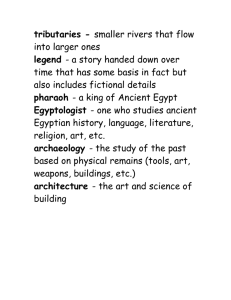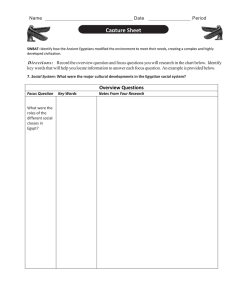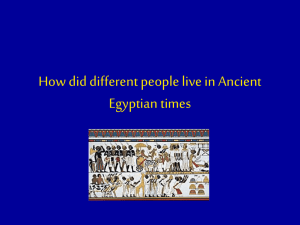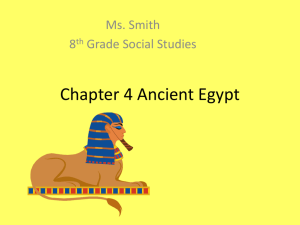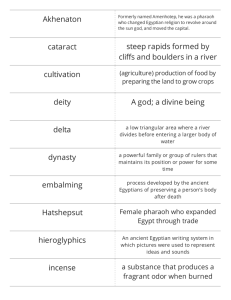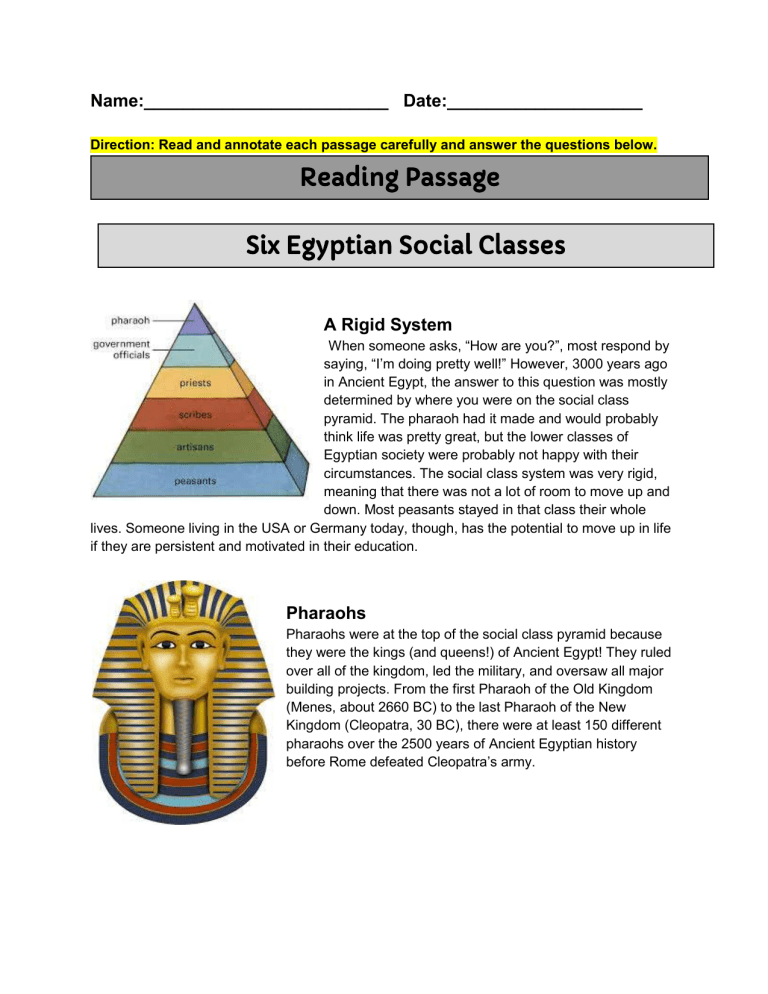
Name:_________________________ Date:____________________ Direction: Read and annotate each passage carefully and answer the questions below. Reading Passage Six Egyptian Social Classes A Rigid System When someone asks, “How are you?”, most respond by saying, “I’m doing pretty well!” However, 3000 years ago in Ancient Egypt, the answer to this question was mostly determined by where you were on the social class pyramid. The pharaoh had it made and would probably think life was pretty great, but the lower classes of Egyptian society were probably not happy with their circumstances. The social class system was very rigid, meaning that there was not a lot of room to move up and down. Most peasants stayed in that class their whole lives. Someone living in the USA or Germany today, though, has the potential to move up in life if they are persistent and motivated in their education. Pharaohs Pharaohs were at the top of the social class pyramid because they were the kings (and queens!) of Ancient Egypt! They ruled over all of the kingdom, led the military, and oversaw all major building projects. From the first Pharaoh of the Old Kingdom (Menes, about 2660 BC) to the last Pharaoh of the New Kingdom (Cleopatra, 30 BC), there were at least 150 different pharaohs over the 2500 years of Ancient Egyptian history before Rome defeated Cleopatra’s army. Government Officials This group of assistants to the Pharaoh were both advisors and administrators, giving words of wisdom and ruling over different areas of Egyptian life. Most officials were wealthy and lived in large houses with many servants. They either earned their positions of power from their family members or from proving their good work ethic to the pharaoh. The vizier was like the pharaoh’s second in command and top judge. In a way, the pharaoh was the president and the vizier was vice president. The chief treasurer was responsible for keeping up with taxes that citizens had to pay and deciding how the government wealth would be spent. The top general in the army was also a close assistant to the pharaoh, as well as the other leaders in the military. Priests Since religion and the afterlife were so important to Egyptians, priests were especially respected in society. Every temple was led by one or more priests as they resided over important ceremonies. The Egyptians worshipped many different gods, and they had an elaborate ritual for the dead where they embalmed the body so they would not decay and mummified the body with white linen cloth. The top priest in the land was called the High Priest, and he was in charge of leading the worship of the gods and the pharaoh. Scribes Scribes were the official writers and were also well-respected. A scribe could come from any social class, allowing those that learned to write the ability to move up to a higher social standing. Scribes wrote the language of the Ancient Egyptians, called hieroglyphics. Scribes could do a number of different jobs. They could write down historical events, contracts, and food supply lists. They could also be asked to calculate taxes, describe court cases, and take a census to determine Egypt’s population. Artisans Artisans are skilled workers who made things by hand. They were usually taught a skill like pottery by another more-skilled artisan, and they would then sell their work in a marketplace. Other than pottery, artisans could also be carpenters that made furniture, weavers that made clothing, and metal-workers that made tools. Artisans could also be jewelers, painters, and sculptors. Although highly skilled, most artisans had a low social status. Peasants Peasants are unskilled workers. Some were slaves, and others were free men and women that had very hard jobs that resembled slavery. Most peasants were either farmers or construction workers. The farmers grew the food for Egyptian society, mostly barley and wheat to make bread. The construction workers were the hands that created the great statues and monuments, some which still stand today like the Great Pyramid at Giza. Peasants had very hard lives. Most peasants were so poor that they only hoped to get enough food to eat each day rather than worrying about what food they wanted to eat each day. ___ 1. Which sentence gives the best summary? A. The six Egyptian social classes were very similar to each other. B. Quality of life in Egypt was mostly determined by one’s social class. C. Pharaohs and government officials were the only people with wealth in Ancient Egypt. D. The geography of Egypt had a profound impact on Egyptian social classes. ___ 2. Based on context, what does the word “census” in paragraph 5 most nearly mean? A. result B. restriction C. structure D. evaluation ___ 3. How is the class of scribes different from other social classes? A. The scribe class is higher than the other classes in rank. B. The scribe class allows lower class members to ascend to a higher rank. C. They were basically government officials. D. Scribes played a part in the Egyptian economy. ___ 4A. What attitude do you think the author has toward the peasant class? A. Sympathy B. Resentment C. Resigned D. Both A and B 4B. Cite evidence from the passage to support your answer to 4A. Use complete sentences, and state what section your evidence comes from.
